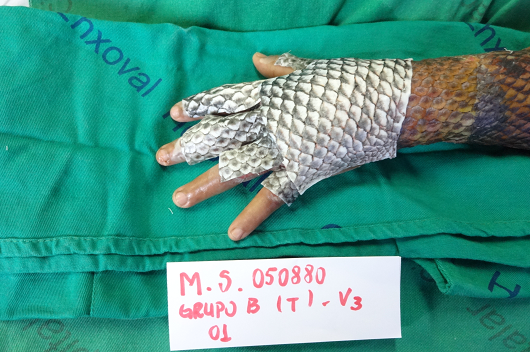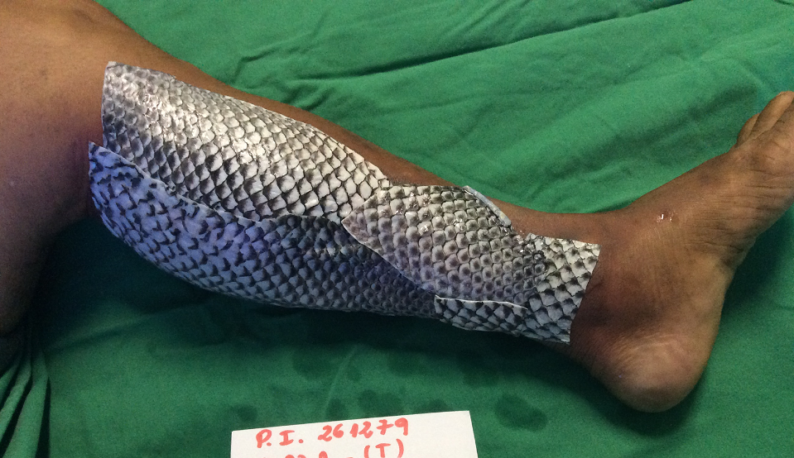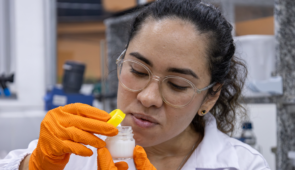Prior to human testing, trials with tilapia skin started in 2015 at the Federal University of Ceará, where 11 stages, called the preclinical phase, were carried out. Only then, the research would be presented to the Brazilian Health Regulatory Agency (ANVISA). After it was approved by the Research Ethics Committee, the skin started to be used on burn victims at the Dr. José Frota Institute (IJF), coordinated by Dr. Edmar Maciel.
Consistently obtaining positive results, skin grafting in the treatment of people with second-degree (superficial and deep) and third-degree burns has already been experimented in several other Brazilian states, surpassing the number of 500 patients.
According to the general coordinator of research, Dr. Edmar Maciel, burns are serious injuries, difficult to treat, and require prolonged hospitalization. They are the cause of severe self-esteem, physical, and psychological damages, affecting especially the people who live in poverty. The doctor explains that, over the course of about 60 years, burn cases in the Brazilian public healthcare system are usually treated with antibiotic ointment, which causes intense pain due to the daily wound dressing changes.

“The usual treatment with ointment requires the aid of many health professionals, as it imposes hydrotherapy sessions for the painful daily wound dressing changes, which increases expenses. The tilapia skin eliminates or drastically reduces the number of changes”, explains Maciel. The doctor, who is also president of the Instituto de Apoio ao Queimado (IAQ), informs that the new treatment provides a 50% reduction in outpatient treatment costs, in addition to reducing pain, since the fish skin does not require removal, in most cases, remaining in the wound until it’s completely healed.
APPLICATION ON ANIMALS
This treatment for burn injuries and wounds has been tested in veterinary medicine as well. More than 50 animals were helped by the several projects and missions carried out in the Pantanal and Uberaba wildfires. Experiments outside Brazil have also used tilapia skin for this purpose. In California, in the United States, supervised by the UFC Professor Odorico de Moraes, the skin was used for treating bears that were victims of forest fires in 2018. This approach is already being developed for burned cats, dogs, and horses.
The tilapia is the first aquatic animal in the world to have its skin used for this type of practice, and the first animal skin treatment in Brazil. This new method led to the creation of the country’s first animal skin bank, located at the UFC Drug Research and Development Center (NPDM), which already produced more than seven thousand skin pieces. The products are designed to be research exclusive, therefore, they are not industrially produced and cannot be commercialized.
APPLICATION IN GYNECOLOGY
The promising results obtained by the burn injury treatment have motivated other groups of researchers to resort to tilapia skin for different types of clinical treatments and surgeries. In 2018, studies in the gynecology field were launched, under the coordination of professors Leonardo Bezerra and Zenilda Bruno, both from UFC’s Maternidade-Escola Assis Chateaubriand (MEAC).
Initially, the skin was used in the vaginal construction of women with Rokitansky syndrome, that is, they were born with a short or even absent vaginal canal. The intervention was successful, which motivates the use of the skin for gender confirmation surgeries (male-to-female).
In Campinas, a surgery for post-cancer vaginal reconstruction was performed using lyophilized (dehydrated) tilapia skin. Furthermore, the material was applied in gender confirmation studies developed and completed in the city of Cali, Colombia, with more than 30 patients. The University of São Paulo (USP) also develops research on vaginal reconstruction of patients who did not have a successful gender confirmation surgery using other techniques.
Concerning these gynecological procedures, tilapia skin has already been used in more than 50 patients.
Source: Edmar Maciel, general coordinator of research on tilapia skin – email address: edmarmaciel@gmail.com
Translation: Isabelly Maia – Research Assistant at UFC’s Translation Laboratory (LETRARE/PROINTER)






